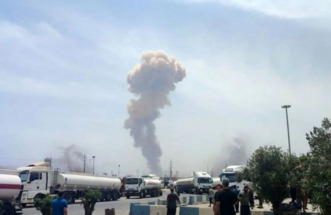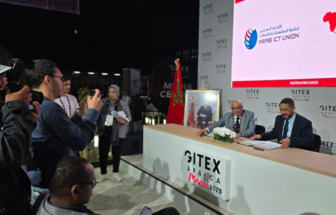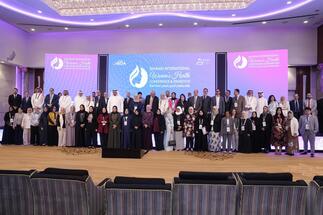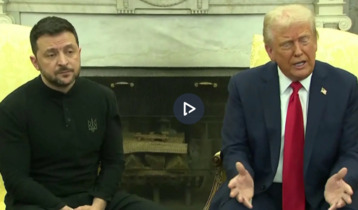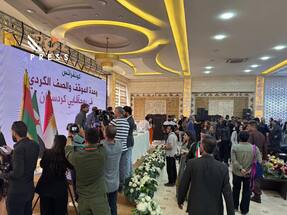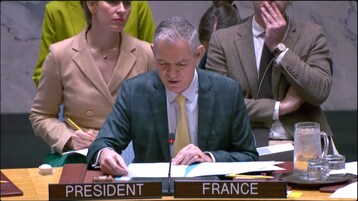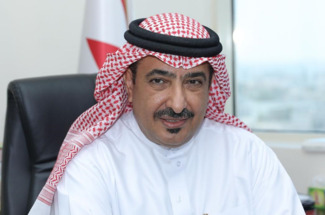-
Hollow building becomes center of Iraq’s uprising
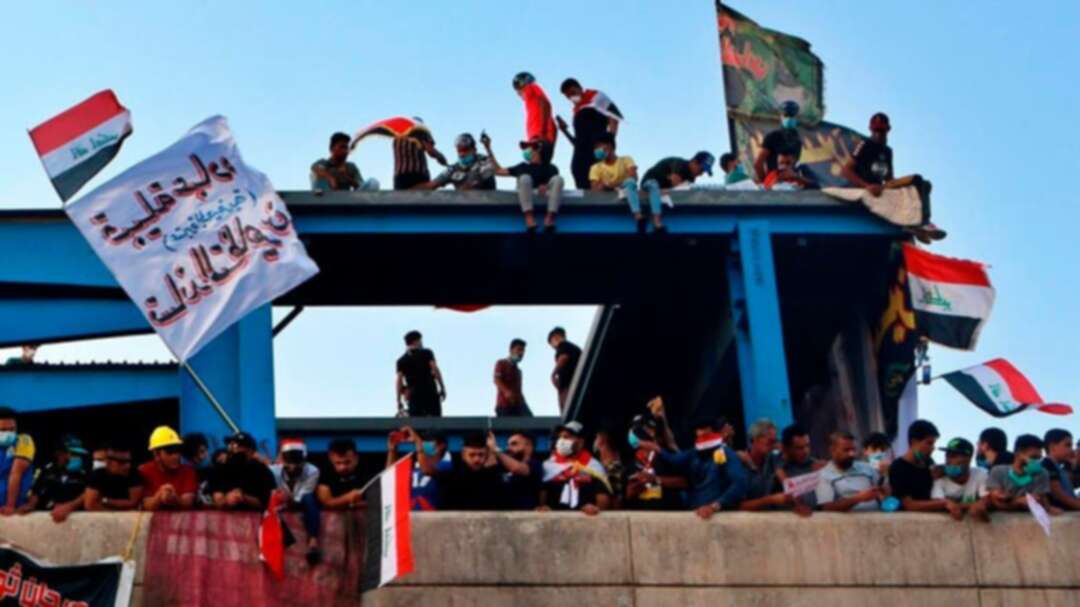
The skeleton of a high-rise building overlooking Baghdad’s central Tahrir Square known as the Turkish Restaurant has become a temporary home and a bustling center for protesters staging demonstrations against Iraq’s ruling elites.
On the ground floor, a group of young men calling themselves the logistical support committee organized stacks of donated clothes, food, and other supplies such as battery packs, blankets and cigarettes on Saturday to keep the once-empty building’s new occupants well-stocked.
“We didn’t know each other but here, we became one,” said Abu Al-Baqir, wielding a large wooden stick. “We are all Iraqis.”
Dressed in combat trousers and wearing an Iraqi flag as a cape, the 35-year-old is the leader of the group, made up of 20-odd young men who occupy a corner of the building’s base.
“We need razors up here!,” shouted a young man wearing a gorilla mask from the third floor, lowering a basket. “And don’t forget the bread, we’re starving!
Groups of young men have occupied all 18 floors of the building, with its cramped unlit narrow staircases. Inside, they dance, smoke shisha, play backgammon and chant for the downfall of the ruling elites.
The mass squat started after a second wave of mass demonstrations against Prime Minister Adel Abdul Mahdi’s government began on the night of October 24.
The demonstrators want to end the post-2003 political order, which they see as endemically corrupt and which has failed to deliver basic services. Abdul Mahdi has promised reforms and a broad cabinet reshuffle but that has so far failed to appease them.
Once a commercial center, the building was bombed in two wars and subsequently abandoned. It has been dubbed the Turkish Restaurant because of the restaurant that occupied its top floor in the 1980s.
Some protesters now call it Mount Uhud, in reference to a mountain in Medina where early Muslims battled those who sought to destroy the nascent religion. That battle ended in defeat.
Makeshift base
Protesters said they took over the building to stop security forces who used it to shoot at them in the first wave of protests in early October. More than 250 people have been killed nationwide since the protests started.
“They tried more than once to enter, they used violence, they used tear gas, some of us died, but we did not leave this building,” said Khalil Ibrahim, a 28-year-old mechanical engineering graduate who introduced himself as the 14th floor spokesman. He has not been able to find work in three years.
“We are staying until this corrupt regime and this subservient government fall,” he said.
On the balcony of the ninth floor, groups of young people draped in Iraqi flags dangled their feet far above the swarms of tuk-tuks and protesters below.
In the distance is the Jumhuriya - or Republic - Bridge, scene of fierce clashes in recent days. It leads to the heavily fortified Green Zone which houses government buildings and foreign missions.
They watched their fellow protesters, barricaded against scrap metal and dumpsters, face security forces firing tear gas.
“I tell them today we are standing here in this building, tomorrow we will be standing in the Green Zone,” said Ahmed Salah, camped out in the building for nine days.
Bringing light
On the lower floors, young people handed out flyers listing their demands. Medical volunteers came to check up the wounded and distribute saline, inhalers, and masks for those in need.
“We’re here to help our children - these young people fighting for their country,” said a 44-year-old doctor who gave only her first name, Sahar. She had brought her son and daughter, also a doctor, to the protests to help distribute the $400 in supplies she brought.
“If we don’t help, who will? Neither the Ministry of Health nor our own hospitals will give us supplies to help treat wounded protesters,” she said.
Nearby, engineer Bashir Ghalib, wearing a white construction hat, was instructing young men setting up an electric grid.
“We worked with volunteers and donors to install electricity in the Turkish Restaurant in six hours while successive governments have not been able to bring light in 16 years,” he said.
source:Reuters
You May Also Like
Popular Posts
Caricature
BENEFIT Sponsors BuildHer...
- April 23, 2025
BENEFIT, the Kingdom’s innovator and leading company in Fintech and electronic financial transactions service, has sponsored the BuildHer CityHack 2025 Hackathon, a two-day event spearheaded by the College of Engineering and Technology at the Royal University for Women (RUW).
Aimed at secondary school students, the event brought together a distinguished group of academic professionals and technology experts to mentor and inspire young participants.
More than 100 high school students from across the Kingdom of Bahrain took part in the hackathon, which featured an intensive programme of training workshops and hands-on sessions. These activities were tailored to enhance participants’ critical thinking, collaborative problem-solving, and team-building capabilities, while also encouraging the development of practical and sustainable solutions to contemporary challenges using modern technological tools.
BENEFIT’s Chief Executive Mr. Abdulwahed AlJanahi, commented: “Our support for this educational hackathon reflects our long-term strategic vision to nurture the talents of emerging national youth and empower the next generation of accomplished female leaders in technology. By fostering creativity and innovation, we aim to contribute meaningfully to Bahrain’s comprehensive development goals and align with the aspirations outlined in the Kingdom’s Vision 2030—an ambition in which BENEFIT plays a central role.”
Professor Riyadh Yousif Hamzah, President of the Royal University for Women, commented: “This initiative reflects our commitment to advancing women in STEM fields. We're cultivating a generation of creative, solution-driven female leaders who will drive national development. Our partnership with BENEFIT exemplifies the powerful synergy between academia and private sector in supporting educational innovation.”
Hanan Abdulla Hasan, Senior Manager, PR & Communication at BENEFIT, said: “We are honoured to collaborate with RUW in supporting this remarkable technology-focused event. It highlights our commitment to social responsibility, and our ongoing efforts to enhance the digital and innovation capabilities of young Bahraini women and foster their ability to harness technological tools in the service of a smarter, more sustainable future.”
For his part, Dr. Humam ElAgha, Acting Dean of the College of Engineering and Technology at the University, said: “BuildHer CityHack 2025 embodies our hands-on approach to education. By tackling real-world problems through creative thinking and sustainable solutions, we're preparing women to thrive in the knowledge economy – a cornerstone of the University's vision.”
opinion
Report
ads
Newsletter
Subscribe to our mailing list to get the new updates!

